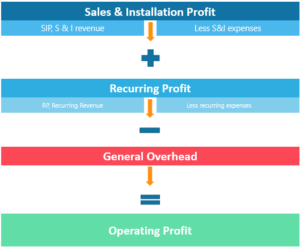The main point of Part 1 is that most security dealers would benefit by separating their ‘steady Eddy’ recurring revenue / profit (RP) from their more messy and volatile Service & Installation revenue / profit (SIP). These two simple buckets will drive your company’s success or failure, because they drive your operating profit.

Knowing your dollars and percent margin for both of these profit centers makes it easy to understand things like your minimum required sales & installation revenue/profit to reach your operating profit goal. What should your goal be?
Claims on Your Operating Profit
If you must pay interest, taxes, and principal of, say, $50,000 this year. That’s how much Operating Profit (OP) you need at a minimum. These are your non-operating expenses. Brokers and financial people use this strange term: EBITDA, which stands for: Earnings Before Interest, Taxes, Depreciation and Amortization. It’s really the same as OP, but it does highlight the various “claims” on your OP. I’ll briefly review each, and two other claims—principal payments, and owner distributions.
Interest and Principal
Your bank or funding company will be owed interest on any borrowing you do, so that interest needs to be paid out of OP. If your company has a line of credit, perhaps to support ups and downs in outstanding receivables, you’ll owe interest in the short term. Sometimes credit lines continue for many years, and grow as your base of business grows.
Many security companies take on “term loans” at some point – loans requiring payment of both interest and principal over a term of 3 – 5 years. These loans could be for vehicles, acquiring accounts from a competitor, buying out another owner, etc. They work like a car loan – fixed monthly installment payments that fully pay off the loan over the term. For example, a $100,000 loan taken at 8% and repaid over 60 months would require a monthly payment of just over $2,000. Only about one third of that payment is interest initially – so the business needs to pay the principal (about $1,300/month) out of net income – income after the ITDA claims mentioned above.
Depreciation and Amortization (D & A)
These two “below the line” expenses can reduce taxable income, and therefore reduce taxes paid. Depreciation is the write-down of a fixed asset, like equipment or vehicles, using a defined schedule. Your accountant will usually set up schedules for depreciation, running for the useful life of the fixed asset. Amortization is very similar, except that it’s a write-down of intangible assets – like security contracts purchased.
Both depreciation and amortization are non-cash expenses—your business has already written a check for the vehicle or the security contract, so this is a mechanism for spreading those investments over future years. Often, the investments being written down involve financing, so one way of looking at D & A is that these non-cash expenses “carve out” cash flow that can then be used to pay interest and principal on the funding.
The Government’s Claim: Taxes
Federal, state and local governments may also have a claim to your OP, in the form of various taxes. If your company is a “C” corporation, it will be liable for federal and possibly state and local taxes. Most small businesses are “pass through” entities, like S Corporations, LLCs, partnerships and proprietorships. Therefore, the income of the business flows through to its owners, on their personal returns.
For example, if a security company has net income – OP minus interest and D & A – of $100,000, that will be treated as business income of the owner(s). Say the owner’s federal tax bracket is 35% — there’d be $35,000 in taxes due.
Owner Distributions
If the owner had used his/her regular salary to pay living expenses during the year, there might not have been enough cash flow left over to cover this $35,000. So an owner might distribute $35,000 from the business to cover taxes. That reduces the company’s equity by the same amount, but allows the owner to cover the government’s claim on the business profits for the year.
Salary, distributions and bonuses to an owner can be a touchy subject. I’ve seen owners take every dime possible out of the business. Nearly always, those businesses are constantly strapped—stretching payables, borrowing more than they should, sweating payroll. Basically, creating lots of stress for the business.
In Part 3 of this series, I’ll go into two things in more detail: owner compensation, and a “zero overhead” way to crunch your numbers.
